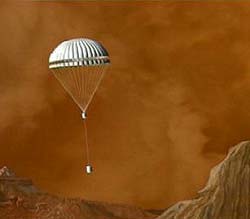’Music2Titan’: sounds of a spaceprobe

Credits: NASA/ESA
When ESA’s Huygens spaceprobe, travelling on board NASA’s Cassini spacecraft en route to Saturn, lands on the planet’s largest moon Titan in January 2005, not only will it carry a variety of scientific instruments, but also music ‘made in Europe’.
Four musical themes composed by French musicians Julien Civange and Louis Haéri were placed on board ESA’s Huygens probe in October 1997. After a seven-year and 4000 million kilometre journey, the music will reach Titan on 14 January 2005. This will be the furthest distance at which human-made sounds will have landed on another celestial body.
The four songs, namely ‘Hot time’, ‘Bald James Deans’, ‘Lalala’ and ‘No love’ were recorded in 1997 at the Sony Studios in New York City under the direction of producer Kirk Yano. The recorded versions on board the spacecraft last for 12 minutes.
The purpose of putting music on the spacecraft is to strengthen the knowledge of ESA’s Huygens mission to Titan, by aiming to leave a trace of our humanity in the unknown and to build awareness about this adventure, especially among young people.
Musician Julien Civange, of the Siliwood-Music2Titan project, said: “Music2Titan reflects our will to embellish Earth and space with unconventional artistic projects, as well as to familiarise youngsters with space missions and the search for traces of extraterrestrial life, communicate about space science outside a scientific framework, and disseminate dreams.”
While waiting to discover the music when Huygens lands on Titan, Siliwood already invites you to go to Music2Titan.com
The Cassini-Huygens mission is a co-operation between NASA, ESA and ASI, the Italian space agency.
For more information
Julien Civange
Siliwood-Music2Titan
Paris, France
Tél: +33 1 4504 04 23
E-mail: hello@siliwoodmusic.com
Franco Bonacina
Spokesman and Head of Media Relations Division
European Space Agency
Tel. + 33 1 5369 7713
Fax. + 33 1 5369 7690
E-mail: franco.bonacina1@esa.int
Media Contact
More Information:
http://www.esa.int/SPECIALS/Cassini-Huygens/SEMYXC2VQUD_0.htmlAll latest news from the category: Physics and Astronomy
This area deals with the fundamental laws and building blocks of nature and how they interact, the properties and the behavior of matter, and research into space and time and their structures.
innovations-report provides in-depth reports and articles on subjects such as astrophysics, laser technologies, nuclear, quantum, particle and solid-state physics, nanotechnologies, planetary research and findings (Mars, Venus) and developments related to the Hubble Telescope.
Newest articles

Innovative 3D printed scaffolds offer new hope for bone healing
Researchers at the Institute for Bioengineering of Catalonia have developed novel 3D printed PLA-CaP scaffolds that promote blood vessel formation, ensuring better healing and regeneration of bone tissue. Bone is…

The surprising role of gut infection in Alzheimer’s disease
ASU- and Banner Alzheimer’s Institute-led study implicates link between a common virus and the disease, which travels from the gut to the brain and may be a target for antiviral…

Molecular gardening: New enzymes discovered for protein modification pruning
How deubiquitinases USP53 and USP54 cleave long polyubiquitin chains and how the former is linked to liver disease in children. Deubiquitinases (DUBs) are enzymes used by cells to trim protein…


